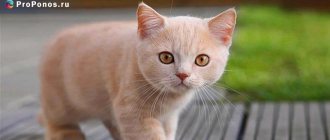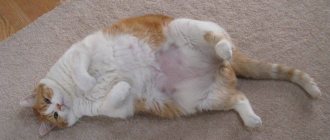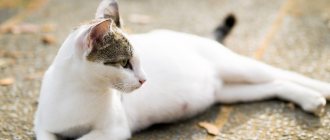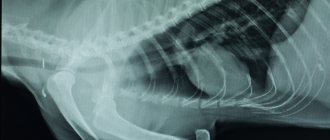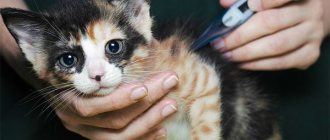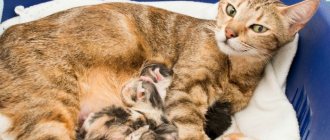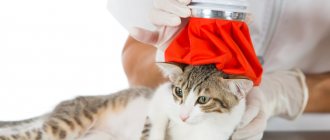Pets often suffer from problems with the digestive system. Often the owner himself is to blame for this, neglecting to properly feed the animal. Fecal retention is fraught with acute intoxication and possible damage to the intestinal walls. To prevent unpleasant consequences, a responsible owner needs to know what to do if his cat becomes constipated.
What can be considered constipation?
Constipation in a cat is a prolonged delay in defecation, making it difficult to completely or at least partially empty the intestines. To identify the problem, count how many times a day your pet visits the litter box. The norm for adult animals is 1 time per day, for older animals – 1 time every two days, for kittens – 2 times per day. The frequency of bowel movements depends on the metabolic rate. The younger the animal, the faster its metabolic processes.
Separately, it is worth considering the feces themselves. In a healthy cat, they should be oblong, soft and dark brown. A change in shape, consistency and color is a reason to contact a veterinary clinic.
Constipation in a cat after sterilization
Constipation in a cat after sterilization or another operation where the animal was given narcotic drugs for general anesthesia is considered a situational intestinal dysfunction. Peristalsis is disrupted (slows down). That's why constipation occurs. The phenomenon is quite common, but extremely undesirable. If the situation is not resolved within a week, then be sure to see a veterinarian for help, because sometimes constipation in a cat after sterilization can be associated with the formation of adhesions.
Adhesions on intestinal loops rarely form, and only if the veterinarian accidentally damaged the intestinal wall during surgery. When the wound begins to heal, the damaged loop “grows” to another. If you start treating your pet on your own, using Vaseline oil for constipation in a cat or other laxatives that begin to increase peristalsis, the intestines may rupture at the site of the adhesions. As a result, peritonitis and death of the animal. Therefore, pay attention to all changes that occur in the animal after surgery. And if something worries you, then immediately see a doctor. Let him check with an ultrasound to make sure there are no adhesions. They will not resolve on their own. Repeated surgery is required.
Reasons for lack of stool
Lack of stool is only a symptom, not a disease. Before starting treatment, you need to understand what the root cause is. Defecation delay occurs when:
- foreign body entering the digestive tract;
- neoplasms or accumulation of hairballs in the intestines, that is, obstruction;
- stress associated with moving, separation from mother or the appearance of new family members;
- inflammation in the anal glands or rectum, accompanied by acute pain when trying to defecate;
- pancreatitis, that is, inflammation of the pancreas;
- poor nutrition – insufficient amount of water, fiber and animal proteins;
- infection with helminths;
- hormonal disorders;
- taking antibiotics, diuretics, anthelmintics and antihistamines;
- excess weight caused by a sedentary lifestyle;
- insufficient hygiene of the tray or unpleasant odor of the litter.
Possible causes also include surgery. If the cat has recently been spayed or neutered, then just wait until the effects of anesthesia wear off. Detailed instructions for care and actions in case of complications can be obtained from your veterinarian.
Causes of constipation in cats
The most common cause of constipation in a cat is a malnutrition (the diet is incorrect, there is no water or succulent food). Indigestion does not occur suddenly. It develops gradually, so you should notice changes in the animal’s condition and behavior (a banal deterioration in appetite or restless visiting the tray).
However, there are other causes of constipation in a cat.
Swallowed Wool
It is not always removed from the intestines normally. Normally, the cat regurgitates it in small lumps. But still, sometimes the wool passes into the intestines, and since it is long, the hairs often become compressed, blocking the lumen of the digestive tract. Because of this, food is digested worse, and feces are even worse. If feces are not removed, the body is poisoned due to the large amount of absorbed toxins. This cause is most often recorded in long-haired cat breeds (Persian, Angora, Siberian and others).
Foreign body in the intestine
Where can it come from? Bones, for example. Many people do not remove small bones from fish or meat, thinking that animals will be happy to chew them. Less often, cats swallow something inedible (unless this is due to an infectious or psychological disease that “forces” the animal to eat everything it sees).
Other reasons
| Pathological processes in the intestines (mainly in the thick section) | We are talking not only about inflammation or ulcers, but also problems with innervation or blood supply. Because of this, the cat’s intestines work worse, peristalsis is greatly impaired and food does not move through. |
| Neoplasms in the intestine itself or the anal sphincter | Which interfere with the normal process of emptying. Also, diseases of the paraanal glands can cause constipation in a cat. |
| Metabolic disorders and related diseases | Diabetes mellitus, obesity, urolithiasis and others. |
| Helminths | Especially if the degree of invasion is very high. Adults can block the lumen in the intestines. The animal develops intestinal obstruction. |
| Infectious diseases | Especially if the pathogen has tropism (“increased selectivity”) to the tissues of the digestive tract. After all, many sores are characterized by either diarrhea or constipation. But in addition to these symptoms, there will be more that will help the veterinarian more accurately determine the cause of your beloved four-legged friend’s illness. |
| Stress | Because of it, the cat may start vomiting, diarrhea, constipation, and the hair will come out in clumps. It’s not for nothing that they say that almost all diseases are caused by nerves. |
Symptoms of the problem
If your pet begins to visit the litter box less often than usual, watch him. For behavioral reasons associated with stale filler, it will regularly make piles in the wrong place. Don't scold your pet for this and change the tray more often. Clean animals rarely walk past their toilet. When an unpleasant odor appears, they can meow loudly, calling on the owner to solve the problem. Be attentive to such situations.
A serious pathology can be indicated when accompanying symptoms appear, including:
- painful and swollen abdomen;
- vomit;
- temperature increase;
- depression and refusal to eat;
- prolonged stay in the tray, accompanied by plaintive meowing;
- mucus or blood in the stool, changes in its color and consistency;
- the presence of blood on the anus or its swelling caused by trauma to the rectum.
The absence of bowel movements, followed by periodic diarrhea, is a sign of enterocolitis, that is, simultaneous inflammation in the small intestine and rectum. Only a doctor can make an accurate diagnosis. After detecting the listed symptoms, be sure to make an appointment with a veterinary clinic.
Symptoms
The absence of feces in the tray is a reason to be wary.
A healthy cat defecates once a day, sometimes less or more often. At the same time, the feces are soft, homogeneous and without lumps. If a cat does not go to the litter box for more than 2 days, then the owner should pay attention to changes in behavior. As a rule, the pet climbs into the toilet and characteristically sits down, but nothing happens (or hard fecal balls with a diameter of 0.5–1 cm are expelled). This is a clear sign of a serious bowel problem.
With difficulty defecating, the cat looks lethargic and painful, does not play, sleeps a lot and rarely eats, the abdomen swells and becomes hard to the touch. In severe cases, the animal develops a fever or begins vomiting.
Often the animal stops licking itself, so it looks untidy. When the owner tries to feel the stomach, it reacts painfully.
An attentive owner will diagnose constipation based on suspicious behavior and visible symptoms.
Heatstroke
Runny nose in cats
Worms in kittens
The veterinarian is not limited to visual examination and palpation of the peritoneum. Additionally, an ultrasound, x-ray is prescribed, and blood and urine tests are taken to rule out other diseases.
The danger of going without bowel movements for a long time
With prolonged absence of stool, feces accumulate in the intestines. If the delay is partial, then the accumulation process lasts longer, but this does not reduce its danger.
Feces are toxic waste. The longer they remain in the body, the more they poison it. This affects the functioning of internal organs and can provoke the appearance of tumors. When a complete blockage occurs, intestinal obstruction occurs - a dangerous condition that can be fatal.
Under the pressure of feces, the intestinal walls can rupture. All contents will enter the body, causing severe intoxication. To avoid the death of your pet, you should urgently contact a veterinary clinic if the cat has not walked for more than 2-3 days in a row.
Treatment of constipation in a cat
What to do if you find your cat is constipated?
Treatment of a cat in which you suspect (or your doctor has confirmed) constipation should be carried out only after consultation with a specialist. Any self-medication is dangerous! It can lead to a deterioration in the animal’s health, including intestinal rupture, peritonitis and death of the cat.
There are several methods of treatment at home, but you should not resort to them without consulting a veterinarian, since each has its own indications and contraindications. But first of all, the cause must be eliminated. If the culprits are helminths, then deworming is needed, if a virus or bacteria is suspected, then specific drugs are needed. If there are adhesions or intestinal obstruction, then surgical intervention is the only option. Without a veterinarian, you may be misdiagnosed and only make things worse. In addition, without eliminating the cause, constipation will not disappear, and you will constantly struggle with it.
Diet
First of all, we start by changing the diet with the addition of fiber (wheat, vegetables, milk). The advantage is that stool becomes softer and easier to remove from the body. There is also a downside - the cat turns into a “gas factory”; it constantly “spoils” the air. In addition, flatulence is not just farting, but also the accumulation of a large amount of gas in the intestines. The animal is in pain, the organs are compressed by the distended intestines and their functions noticeably deteriorate.
Vegetable oil
Adding just two drops of vegetable oil to your diet daily. For a cat with constipation, this amount is enough to make stools more frequent and softer. However, again, there is a minus - the oil has a negative effect on the liver. This method of treatment should be abandoned if the pet is old or sick. And young people should not spoil their liver from their youth - it will come in handy later.
Laxatives
But along with them, they must be given those drugs that support and restore beneficial microflora - Duphalac, Lactusan, for example. But they can only be given after consultation with a veterinarian, who will check that there are no contraindications for the use of laxatives (foreign bodies or neoplasms in the intestines, adhesions, etc.), and will also name the dosage and frequency of use.
Enema
But you shouldn’t install it at home yourself, because without experience you can cause pain to the animal, injure the rectum, incorrectly calculate the volume of liquid administered rectally, and also make a mistake with its temperature.
Vaseline oil for constipation in cats
Although they say that Vaseline oil is an ideal remedy for constipation in a cat, it should not be given without examination by a veterinarian. Your doctor will calculate the dosage based on your pet's size, age, and weight. Usually a single dose is 5 ml, given several times a day. However, under no circumstances should it be given together with other oils (for example, vegetable oil). Poor liver, it won’t withstand such a load.
The treatment is that Vaseline oil for constipation in a cat softens feces, envelops the intestinal walls, which allows the pet to painlessly relieve itself.
How to help an animal first
Eliminate feeding for a couple of days. This will reduce the load on the intestines. To soften stool, ensure adequate fluid intake. If your pet avoids water, drink it through a syringe without a needle.
A cat constipation laxative should only be prescribed by a veterinarian. Independent choice of medications is fraught with intensification of the inflammatory process. To alleviate the condition, before visiting the veterinary clinic, you can give your pet Vaseline oil, but only if there is no vomiting.
Unlike adult cats, constipation in kittens is often associated with separation from the mother too early. Try giving them a light massage, moving along the tummy towards the anus. Massage movements stimulate peristalsis and help with bowel movements.
If you are not sure of the reason, then it is better to entrust the kitten to specialists. He is more vulnerable to intoxication, and his intestines become clogged with waste faster. If presentation is late, the baby may need the help of a surgeon.
Preventing constipation in cats
- Review your diet. It must contain fiber and a sufficient amount of moisture (if the food is natural, then more vegetables, if the food is dry, then read the composition).
- Comb out excess hair. Give special medications or food that will allow the swallowed fur to regurgitate rather than go further into the intestines.
- Visit your veterinarian for routine checkups. The doctor will examine the pet and rule out inflammatory processes in the digestive tract.
- Provide your animal with active walks. It is advisable to “drive” it an hour after eating, because physical activity after eating food “revives” intestinal peristalsis, so the feces move faster and do not have time to dry out and become compressed.
- Don't forget about vaccinations and deworming. Regularly, according to schedule, not forgetting to mark these events in the animal’s passport.
If you still have questions about treating constipation in a cat, write them in the comments - we will try to answer!
Treatment options
Knowing the possible ways to treat constipation in a cat, you can easily avoid dangerous consequences. In the absence of accompanying symptoms and a single problem with bowel movements, you can cope with the situation on your own.
Drug therapy
It is recommended to consult a veterinarian before taking medications. By describing the animal's condition, you can find out what can be given to a cat for constipation and what cannot be given. Depending on the situation, your doctor may recommend the following types of laxatives:
- Volume-forming agents (Metamucil)
. They attract additional moisture from cells, increasing the volume of feces. Not suitable in an emergency situation.
- Emollients (Docusate sodium)
. Suitable for emergency emptying. Contraindicated when feeding or expecting offspring.
- Osmotic (Duphalac, Lactusan)
. Softens stool and stimulates peristalsis. Not suitable for urgent care, but have a beneficial effect on microflora.
- Lubricants (pastes for hair removal)
. They ensure free sliding along the intestinal walls by moisturizing them.
- Stimulants (Bisacodyl)
. They stimulate the contraction of intestinal muscles and help get rid of obstruction in a short time. Contraindicated for pregnant and lactating pets.
Self-administration of laxatives can lead to severe dehydration, so do not experiment on your pet. Sometimes it’s enough just to change the filler or change the diet. And leave anything more complicated to the doctor.
Castor or Vaseline oil
The most popular folk remedies are castor oil and Vaseline. Vaseline oil does not accumulate in the body, so it is difficult to overdo it with the dosage. Veterinarians recommend giving 1 ml per 1 kg of animal weight using a syringe or syringe. Once in the body, the oil softens stagnant feces and promotes their removal.
But it’s better to be careful with castor oil. The cat's body is not compatible with it, so instead of relief, you will cause your pet severe stomach pain.
Is it possible to give an enema?
Treatment of constipation in cats and kittens at home with an enema is permissible only after examination by a doctor. This procedure is prohibited for chronic pathologies and obstruction, as it can aggravate their course.
Working with an enema is complicated by unpleasant sensations. In the absence of skills, the pet will constantly break out, and a successful outflow of feces can “decorate” a considerable part of the room. If the veterinarian gives the go-ahead and you are not afraid of difficulties, read the detailed instructions and proceed with the procedure.
Why you shouldn’t use folk remedies
The main danger of folk remedies is the unpredictability of the body's reaction. The cat may develop allergies or severe poisoning. Healing decoctions are good in complex therapy, but only under the guidance of a doctor who has checked the absence of an allergic reaction to the main components. It will not be possible to eliminate the problem without more effective drugs.
Nutrition correction
At the initial stage of the disease (partial emptying of small balls), you can try to improve nutrition. Start feeding your pet:
- fractionally, increasing feedings to 6 times a day;
- more liquid food, soaking dry granules or adding broth to prepared dishes;
- lean ground meat and raw liver;
- ground pumpkin, carrots and beets, or simply feed the cat their juice through a syringe;
- milk porridges and fresh fermented milk products (yogurt, kefir).
Avoid foods that increase gas formation (legumes, yeast products), bones and cartilage. Temporarily eliminate rice, which has a strengthening effect, from your diet. Add a small amount of bran and vegetable oil to the dish (0.5 tsp per day), which stimulate peristalsis.
When using dry food, pay attention to the veterinary ruler marked i/d. These products are rich in coarse dietary fiber, as they are designed for those who suffer from digestive problems.
Massage
Not all pets are ready to let a person near their belly. If the animal trusts you, then try to accustom it to a light massage. Stroke your pet's belly clockwise at any free time. The procedure can be carried out with bare hands or a cloth dipped in cool water.
How to help a cat with constipation?
Now let's look at methods that will relieve your cat of constipation. It is important to understand that first aid is only relevant if the animal behaves normally and does not visually look too painful.
Contact your doctor immediately if you notice:
- Changes in pigmentation of the mucous membranes (cyanosis, pallor).
- A sharp decrease or increase in body temperature.
- Nausea and other signs of poisoning.
- Severe pain syndrome - the cat screams, does not allow the belly to be touched, the peritoneum is hard and tense.
- Inflammation or swelling of the anus.
If constipation is spastic in nature, that is, it arose due to a number of unfavorable factors, you need to start with gentle measures. For example, abdominal massage, gentle but long-lasting and regular, gives good results. Massage the peritoneum by palpating it clockwise with your fingers. A good sign is gurgling in the intestines “in response” to a massage. This means that the intestines are working and peristalsis is preserved.
If your pet has not gone to the toilet during the day, you can resort to universal laxatives. Duphalac is considered a safe medication; it is prescribed even to infants. For the first dose, the cat is given a prophylactic dosage. After a few hours of observation, the drug can be repeated. Treatment with Duphalac must be combined with abdominal massage, and also provide warmth, peace and comfort to the animal.
Note! During constipation, it is advisable that the cat does not receive food, but is provided with unhindered access to water.
In parallel with the massage, you can and should give the animal probiotics. Constipation can occur against the background of dysbiosis or provoke it. In any case, and with any disruption of the digestive system, the microflora suffers, which needs to be restored. Probiotics can be given to your cat in two forms:
- Medicinal supplements.
- Fermented foods – Homemade yogurt or kefir is a rich source of beneficial lactobacteria and bifidobacteria.
If the cat suffered from dysbacteriosis and prior to constipation, it is better to use special preparations that contain live lactobacilli. Typically, drugs are sold in the form of a suspension or in powder form, which must be diluted in water or a special catalyst and given to animals. As aids, you can use drugs from a regular pharmacy, for example, Linex, Hilak Forte, Bifiform and others.
Important! The popular Lactusan is not suitable for the treatment of dysbiosis in all cats. Statistically, 40% of adult animals develop lactose intolerance, and Lactusan consists of a structural isomer of milk sugar, that is, lactose, which is obtained artificially.
Relatively safe laxatives include:
- Enema Microlax - sold in a disposable tube with a capacity of 3 to 5 grams. The drug quickly coats the intestinal walls and provokes bowel movements.
- Osmotic type laxatives, for example, Normaze . With proper and timely use, the drug quickly and gently eliminates constipation. An overdose is practically impossible, but the drug has contraindications: lactose intolerance, vomiting, acute pain, intestinal obstruction (!), arterial stenosis, damage to the intestinal mucous membranes, bleeding in the intestines (regardless of the etiology) and dehydration.
- Contact laxatives, such as Senade . The drug directly affects the large intestine, causing it to work more actively and contract. Almost all drugs of this type have a wide range of contraindications.
Note! Contact laxatives are considered safer than osmotic laxatives, but for people...and not for everyone! Self-treatment of a pet can end tragically, so consciously weigh all the risks when resorting to the use of drugs not prescribed by a doctor.
Treatment of constipation in cats with folk remedies
Let's start with the most common and pleasant way to treat constipation in cats. Many experienced owners confirm that condensed milk can help with constipation in a cat quickly (within a few hours) and gently. Oddly enough, it is true that the composition of real condensed milk stimulates intestinal motility. Condensed milk must be diluted with clean water (1:1). Most often, the cat drinks the “medicine” on its own.
Oil can also help relieve constipation. It is advisable to use only flaxseed oil, since it is properly broken down in the cat’s body and will not cause harm. Even if flaxseed oil does not provoke bowel movements, it will have a beneficial effect on irritated intestinal walls.
If you don’t have linseed oil, this will do:
- Vaseline oil.
- Vegetable oil (sunflower, refined, hot-pressed, purified).
- Olive oil.
- As a last resort, castor oil (can cause severe vomiting).
Vaseline suppositories are a good and proven remedy that cannot be used for intestinal blockage or volvulus. In other cases, even if the candles don’t help, they won’t make things worse. Vaseline envelops injured mucous membranes and promotes their recovery.
When do you need veterinary help?
You cannot do it on your own if any alarming symptoms appear that affect your pet’s usual state. A plaintive meow is a signal for help. Listen to your mustachioed pet and try to put off all other things until you find out the cause of the problem.
After abdominal surgery, carefully monitor the timing. Delayed bowel movements in the first days are explained by refusal to feed and weak peristalsis inhibited by anesthesia. If the condition does not return to normal within 2 days, contact your doctor. The cause of the delay may be damage to the walls of the rectum. In this case, repeat surgery will be required.
Treatment. What to do if your cat is constipated.
If an animal does not go to the toilet for 2-3 days, feces accumulate inside it. To alleviate the condition drugs with a laxative effect , for example Duphalac , 1–1.5 ml twice a day for an adult animal weighing 3–5 kilograms. Also provide access to clean drinking water without restrictions.
If constipation is caused by a foreign object in the intestines, laxatives are contraindicated and endoscopic or abdominal surgery is necessary.
Some drugs from the “human” pharmacy that have a laxative effect are toxic and even dangerous for cats. Therefore, before using medications from your home medicine cabinet, consult your veterinarian.
At home, Vaseline oil to soften stool and speed up bowel movements.
Dosage – 1.5–2 milligrams per kilogram 2 times a day. Replacing oil with vegetable, butter or castor oil is strictly prohibited.
Milk causes mild diarrhea in cats, so milk and fermented milk products are recommended as a gentle laxative.
Abdominal massage. The person strokes the pet's belly with light pressure in a clockwise direction. Then, you need to wait 10-15 minutes, repeat if necessary.
Cleansing enema. To perform the procedure you will need: a rubber bulb with a capacity of 100–200 ml, warm boiled water (pink solution of potassium permanganate), cream or Vaseline and an assistant. Fill the bulb with water and lubricate the tip with cream or Vaseline. An assistant fixes the cat, after which the tip of the bulb is inserted into the rectum to a depth of 2–3 cm.
The solution is injected slowly and carefully, then the tip is removed and the cat is allowed to walk. Be prepared, sometimes bowel movements begin 5-10 seconds after the end of the enema, so the cat does not have time to run to the litter box.
Prevention
- Keep your diet balanced and the quality of your food. Choose food with sufficient protein and dietary fiber. Or introduce kefir, liver, pumpkin, grain porridge, and beets into your diet;
- Brush your furry friend so that excess hair does not get into the intestines when washing;
- To prevent the formation of hairballs inside the cat, use a special paste ( Cliny, Gimpet Malt-Soft Extra ) or phytomines for hair removal in tablets;
- Grow grass for cats on the windowsill, replacing phytomines with grass;
- Play with your pets more often, take them for walks.
Side effects
If for some reason the owner decides to opt for castor oil, he should be aware of the side effects that very often occur .
- Nausea, vomiting . These unpleasant symptoms may begin 30-40 minutes after taking the product. The owner is unlikely to be able to predict in advance how the animal’s body will behave in a given situation. That is why many people still prefer not to take risks and refuse to use castor oil in advance.
- Poisoning of the body . The cat may simply begin to have diarrhea and additional symptoms may appear, indicating obvious trouble. These include not only noticeable stool disturbances, but also intense pain and general intoxication of the body. It is unlikely that a loving owner would wish his pet to experience such torment. After all, you can cope with simple constipation, which is not complicated in any way, by much more harmless means. For example, petroleum jelly does not bear any burden on the body at all and helps to provide the desired effect in a timely manner.
